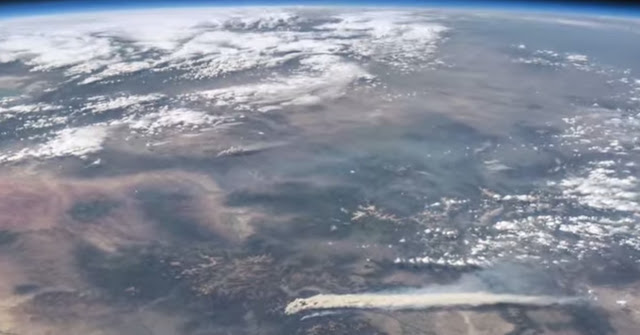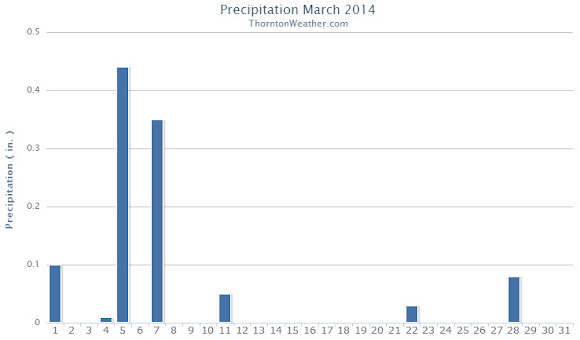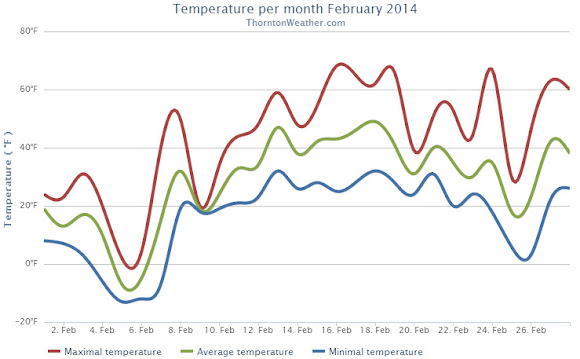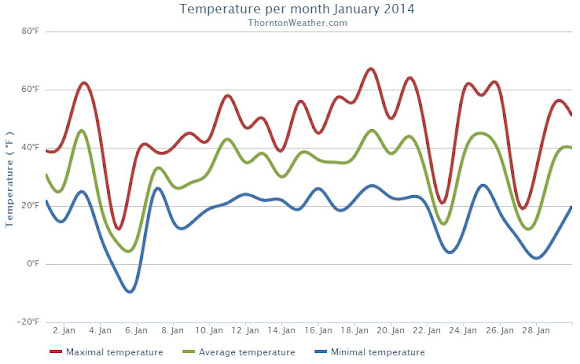The month of April lacked much in the way of drama for northeastern Colorado. Overall temperatures were warmer than normal and precipitation and snow were lacking a bit.
April started out on the cool side and brought the first snow of the month on the 3rd. By the 8th temperatures had rebounded and we enjoyed a five-day stretch of high temps in the 70s.
A storm system and cold front cooled things down on the 13th and we saw a couple of days of light snowfall. As always the weather bounced back and Thornton recorded its first 80+ degree day of the year on the 18th.
The final four days of the month saw things turn cool again. Some light rain was seen but the bigger story was a period of unusually windy conditions.
Denver’s average April temperature is 47.4 degrees (1981 – 2010). For April 2014, the average temperature in Thornton was more than two degrees higher at 49.6 degrees. Out at Denver International Airport, the average came in a bit cooler at 49.0 degrees.
Temperatures in Thornton ranged from a high of 81.3 degrees on the 18th down to a low of 17.6 degrees on the 14th. DIA saw its warmest reading of 80 degrees on the 22nd and its coldest of 18 degrees on the 14th.
Low temperatures dropped below freezing on 11 days in Thornton. No readings below zero were recorded.
In terms of precipitation, Thornton measured 0.97 inch in the bucket. This is a good ways below the Denver April average of 1.71 inches. DIA saw more precipitation than us with a reading of 1.24 inches.
Similarly, snowfall fell short of normal in Thornton and Denver. On average the Mile High City sees 6.8 inches in April. Thornton recorded only 5.5 inches and DIA 5.6 inches.
Click here to view Thornton’s March 2014 climate report.


CLIMATE REPORT
NATIONAL WEATHER SERVICE BOULDER, CO
603 AM MDT THU MAY 1 2014
...................................
...THE DENVER CO CLIMATE SUMMARY FOR THE MONTH OF APRIL 2014...
CLIMATE NORMAL PERIOD 1981 TO 2010
CLIMATE RECORD PERIOD 1872 TO 2014
WEATHER OBSERVED NORMAL DEPART LAST YEAR`S
VALUE DATE(S) VALUE FROM VALUE DATE(S)
NORMAL
................................................................
TEMPERATURE (F)
RECORD
HIGH 90 04/30/1992
LOW -2 04/02/1975
HIGHEST 80 04/22 90 -10 80 04/29
LOWEST 18 04/14 -2 20 6 04/10
AVG. MAXIMUM 62.8 61.5 1.3 54.7
AVG. MINIMUM 35.2 33.3 1.9 28.7
MEAN 49.0 47.4 1.6 41.7
DAYS MAX >= 90 0 0.0 0.0 0
DAYS MAX <= 32 0 0.3 -0.3 4
DAYS MIN <= 32 10 13.0 -3.0 17
DAYS MIN <= 0 0 0.0 0.0 0
PRECIPITATION (INCHES)
RECORD
MAXIMUM 8.24 1900
MINIMUM 0.03 1963
TOTALS 1.24 1.71 -0.47 1.87
DAILY AVG. 0.04 0.06 -0.02 0.06
DAYS >= .01 6 9.1 -3.1 13
DAYS >= .10 5 4.5 0.5 7
DAYS >= .50 0 0.9 -0.9 0
DAYS >= 1.00 0 0.5 -0.5 0
GREATEST
24 HR. TOTAL 0.48 04/02 TO 04/03 0.50
04/22 TO 04/23
SNOWFALL (INCHES)
TOTAL 5.6 6.8
DEGREE_DAYS
HEATING TOTAL 472 529 -57 690
SINCE 7/1 5730 5731 -1 5802
COOLING TOTAL 0 1 -1 0
SINCE 1/1 0 1 -1 0
FREEZE DATES
RECORD
EARLIEST 09/08/1962
LATEST 06/08/2007
EARLIEST 10/07
LATEST 05/05
......................................................
WIND (MPH)
AVERAGE WIND SPEED 12.9
RESULTANT WIND SPEED/DIRECTION 2/299
HIGHEST WIND SPEED/DIRECTION 49/340 DATE 04/29
HIGHEST GUST SPEED/DIRECTION 66/340 DATE 04/29
SKY COVER
POSSIBLE SUNSHINE (PERCENT) MM
AVERAGE SKY COVER 0.70
NUMBER OF DAYS FAIR 1
NUMBER OF DAYS PC 22
NUMBER OF DAYS CLOUDY 7
AVERAGE RH (PERCENT) 50
WEATHER CONDITIONS. NUMBER OF DAYS WITH
THUNDERSTORM 0 MIXED PRECIP 0
HEAVY RAIN 0 RAIN 3
LIGHT RAIN 8 FREEZING RAIN 0
LT FREEZING RAIN 0 HAIL 1
HEAVY SNOW 2 SNOW 3
LIGHT SNOW 6 SLEET 0
FOG 8 FOG W/VIS <= 1/4 MILE 2
HAZE 1
- INDICATES NEGATIVE NUMBERS.
R INDICATES RECORD WAS SET OR TIED.
MM INDICATES DATA IS MISSING.
T INDICATES TRACE AMOUNT.












 February in Colorado typically brings to an end an extended period when average temperatures are at their lowest. Winter begins to loosen its grip and temperatures get warmer but precipitation is not a particularly common event during the month.
February in Colorado typically brings to an end an extended period when average temperatures are at their lowest. Winter begins to loosen its grip and temperatures get warmer but precipitation is not a particularly common event during the month.